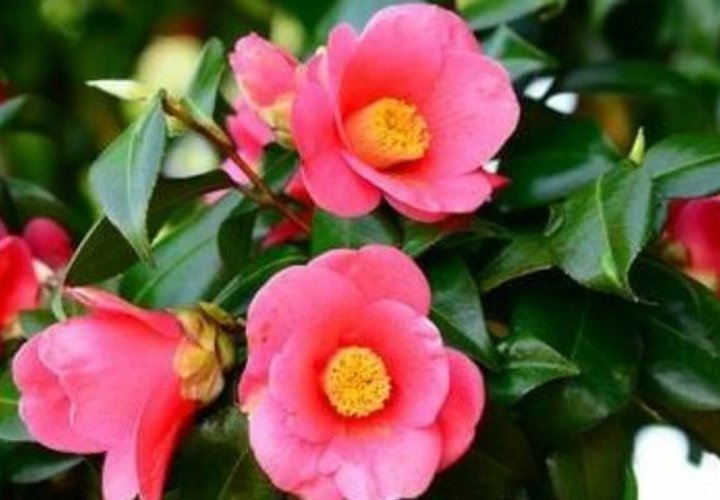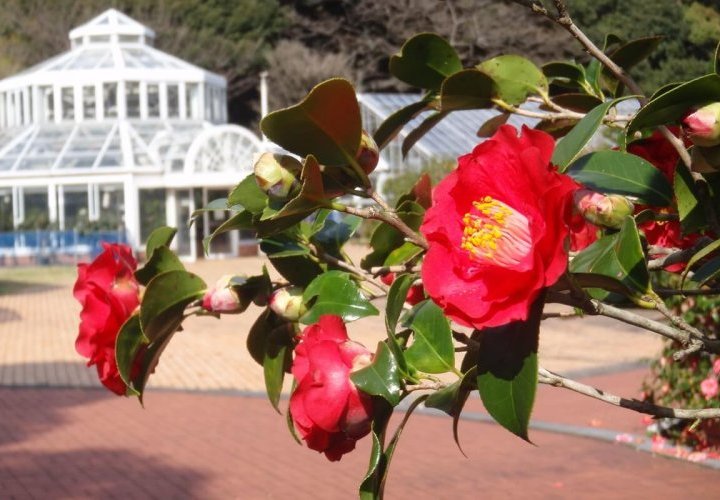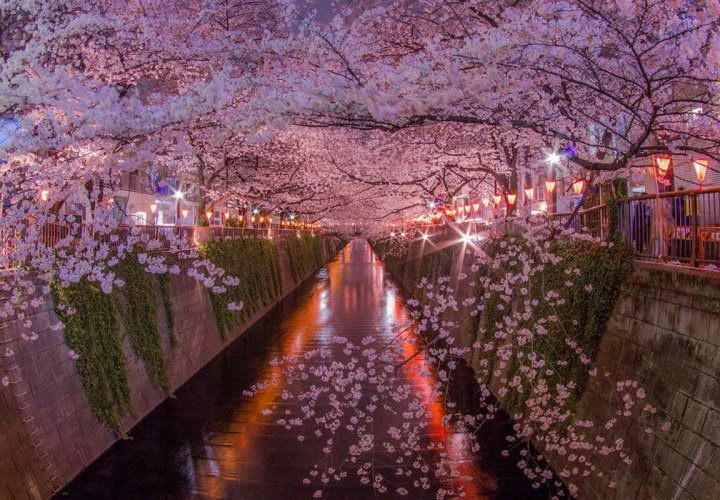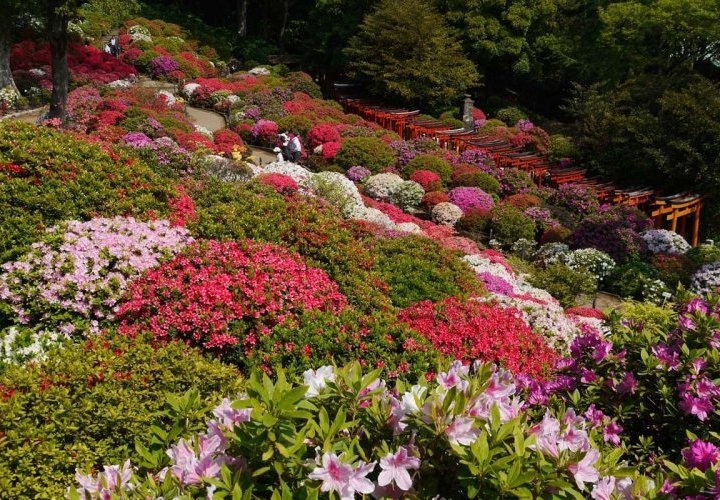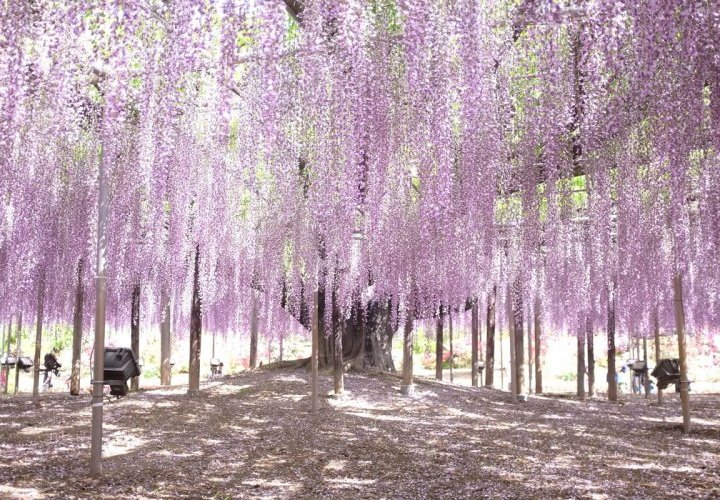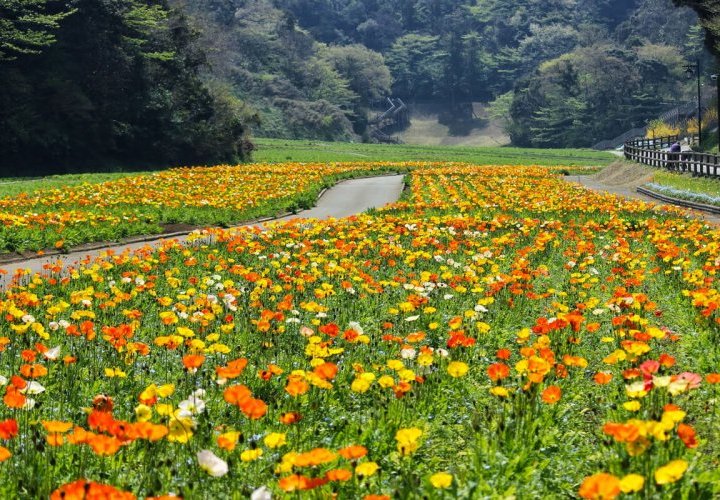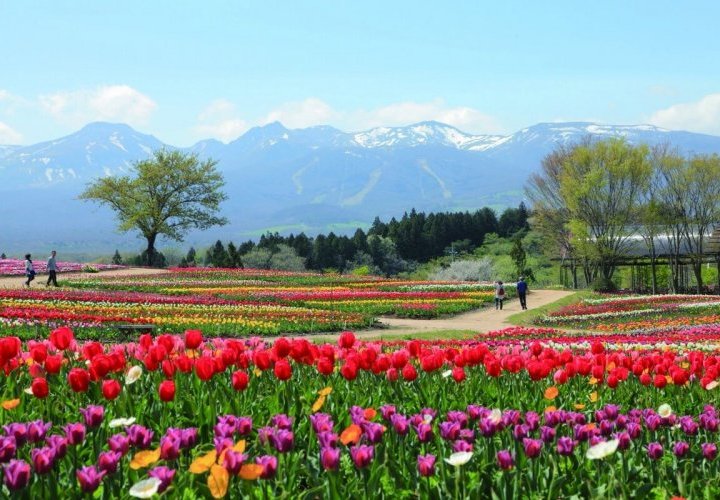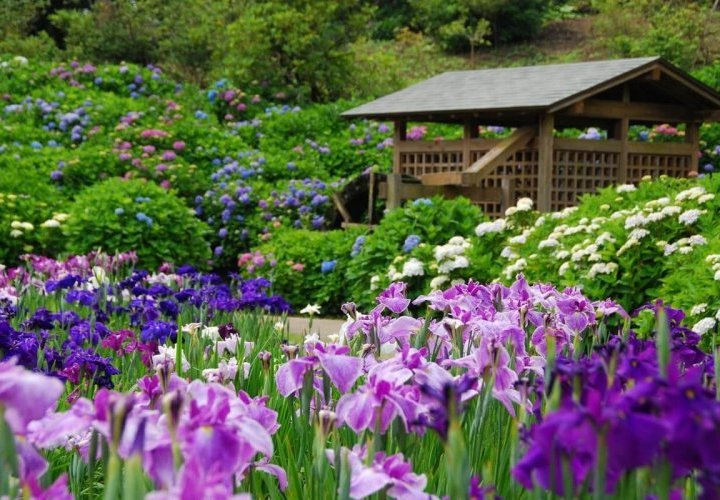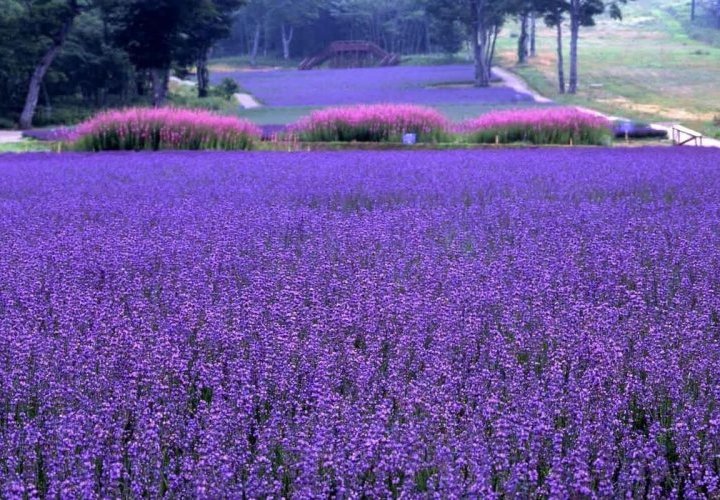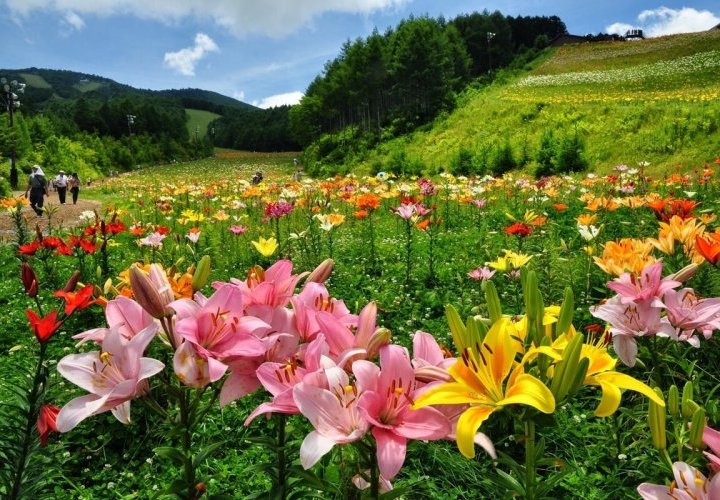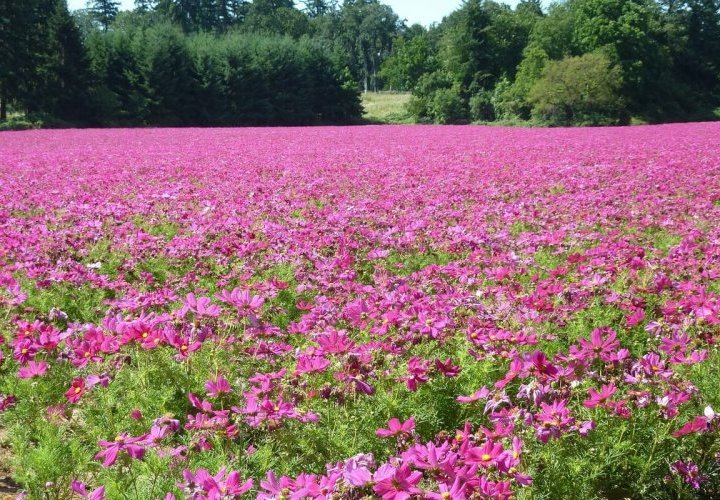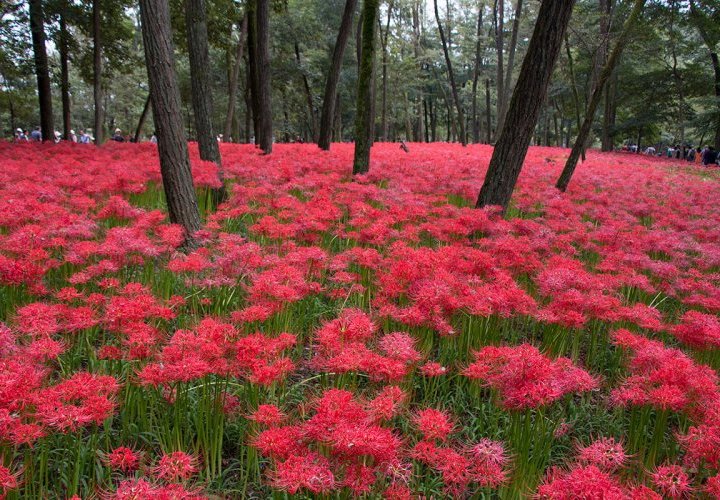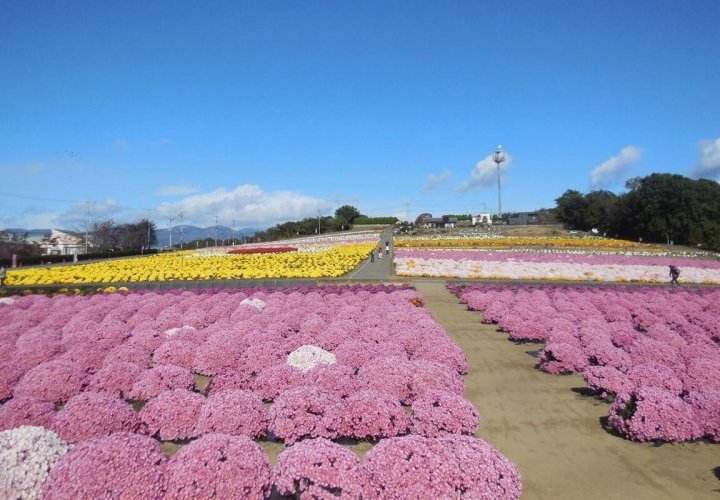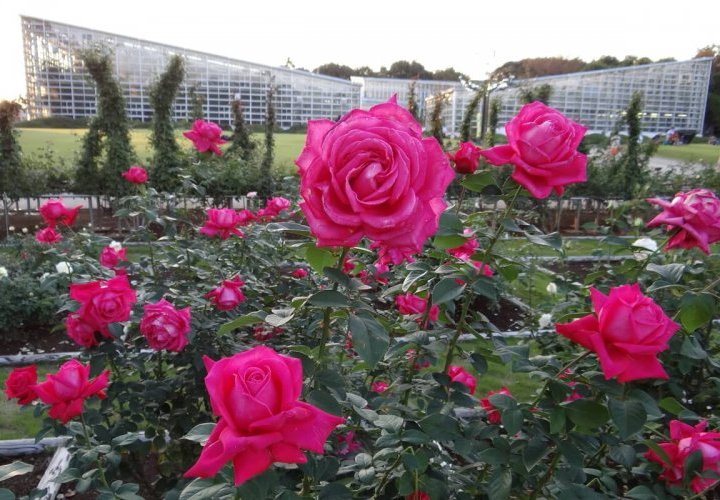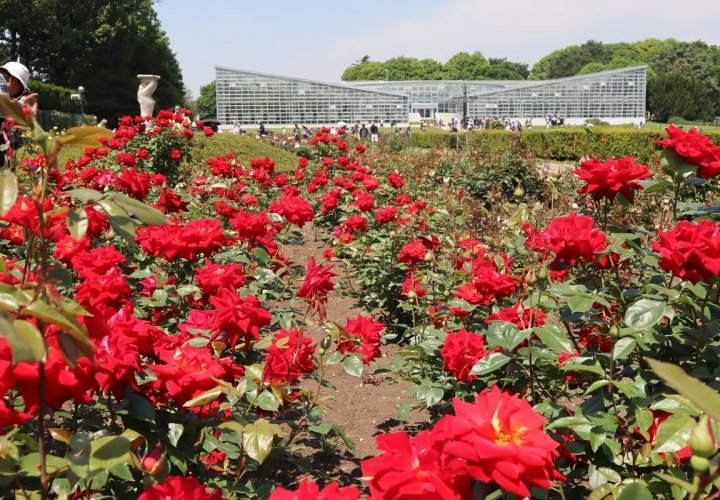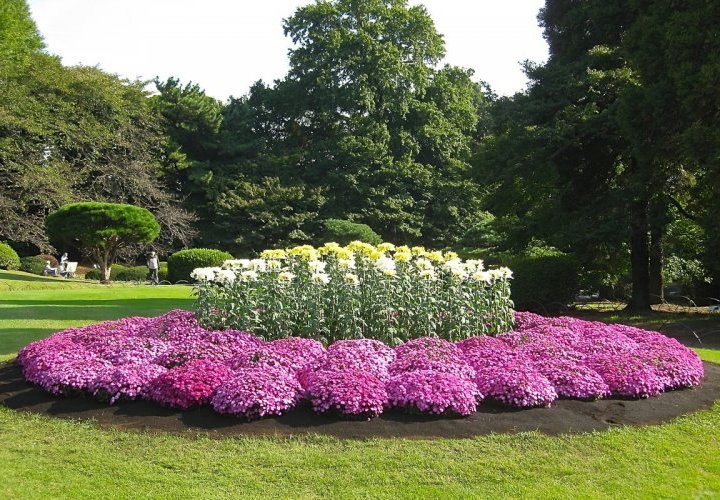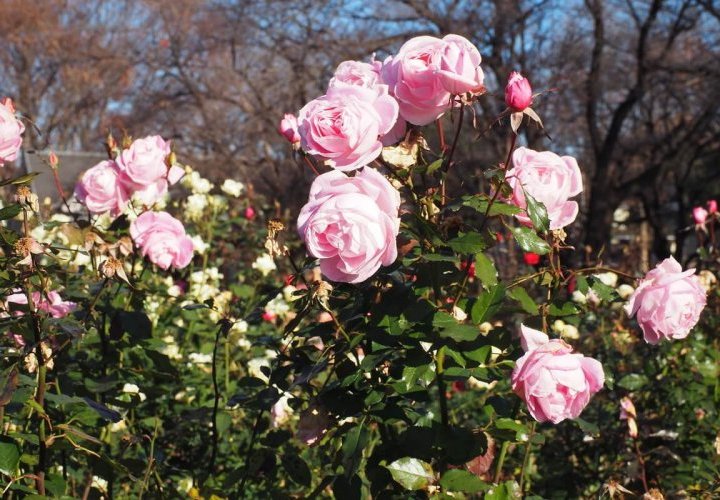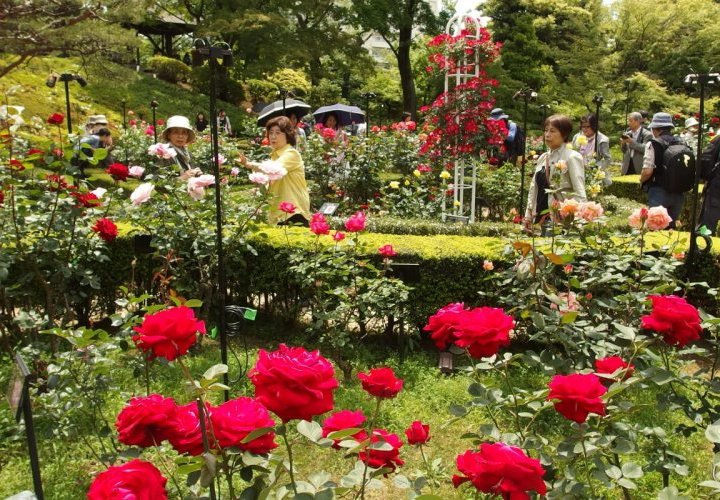Camellia in Tokyo Metropolitan Oshima Park, Oshima (late January to late March)
Tokyo Metropolitan Oshima Park was established in 1938 and is located in the northeastern part of Oshima Island. Stretching over an area of about 3.27 square kilometres, the park has about 3,200 trees of around 1,000 species and cultivars, and around 5,000 camellia japonica trees and bushes. Camellia japonica was introduced to Europe from Japan in the Edo period and many cultivars were bread there. The camellia garden from the park is among the largest camellia gardens in Japan being divided into 9 zones: zone of foreign cultivars, zone of the cultivars sorted by colour (red, white, yellow, purple, black or pink), zone of the cultivars for tea ceremony, zone of wild species of Camellia, zone of Camellia sasanqua cultivars, more
Tokyo Metropolitan Oshima Park was established in 1938 and is located in the northeastern part of Oshima Island. Stretching over an area of about 3.27 square kilometres, the park has about 3,200 trees of around 1,000 species and cultivars, and around 5,000 camellia japonica trees and bushes. Camellia japonica was introduced to Europe from Japan in the Edo period and many cultivars were bread there. The camellia garden from the park is among the largest camellia gardens in Japan being divided into 9 zones: zone of foreign cultivars, zone of the cultivars sorted by colour (red, white, yellow, purple, black or pink), zone of the cultivars for tea ceremony, zone of wild species of Camellia, zone of Camellia sasanqua cultivars, more
zone of the cultivars sorted by native region, zone of the cultivars sorted by blooming season, zone of Camellia reticulata cultivars, zone of the cultivars of bud and leaf variations. The garden has a Camellia Pavilion with a Camellia Museum that opened in the garden in 1989. During the Camellia festival (from the end of January to the end of March), the Exhibition Greenhouse where fragrant camellias, foreign species and some European cultivars are exhibited is open to visitors.
Plum blossoms at Yushima Tenjin Shrine, Tokyo (early February to early March)
The plum flower is one of the most beloved flowers in Japan. It is the symbol of the beginning of spring and usually starts blooming from February to March for about a month. During the blooming season, over 300 plum trees of different varieties bloom beautifully at Yushima Tenjin Shrine in Bunkyo Ward, Tokyo. Bunkyo Plum Blossom Festival is held here from early February to early March. Many special events are organized during this event including traditional dance and music performances. Moreover, the light-up of plum trees is also available after the sunset.
Plum blossoms in Kairakuen Garden, Mito (mid-February to late March)
Kairakuen Garden is a large traditional Japanese garden located in Mito city, Ibaraki Prefecture. It is considered as one of the three greatest Japanese landscape gardens along with Kenrokuen Garden in Kanazawa city and Korakuen Garden in Okayama city. The garden was built in 1841 by the local lord Tokugawa Nariaki with the purpose of being enjoyed by the public. The name of the garden “Kairakuen” literally means “a park to be enjoyed together” in Japanese. Kairakuen Garden lies on an area of 300 ha and is home to over 3,000 plum trees of about 100 varieties. It is one of the most popular places in Japan for plum blossom viewing and the visitors can enjoy various plum blossoms in white, pink and red colours.
Mito Plum Blossom Festival or Mito Ume Matsuri is held annually in the garden from mid-February to late March. During the festival, special events are organized including candle light art, plum wine and tea ceremony. The plum trees are lit up after sunset and a different scenery compared with the daytime can be enjoyed at night.
Cherry blossoms in Mitsuike Park, Kumagaya (mid-March to early April)
Mitsuike Park literally means “three ponds park” and is ranked as one of the top 100 cherry blossom-viewing spots in Japan and 50 best places to see birds in the Kanagawa area. The three ponds are surrounded by 1,600 cherry blossom trees including Somei Yoshino, Shidarezakura (weeping cherry) and Kanzakura varieties.
Cherry blossoms in Yoyogi Park, Tokyo (mid-March to mid-April)
Yoyogi Park is the fifth largest urban park in downtown Tokyo, owing more than 10,000 trees of which 730 are sakura trees. The park features fresh air and leisure atmosphere, especially during the cherry blooming season and that is why people often arrive early to occupy good seats under or near the cherry blossom trees. At the Meiji Shrine that is located near the park, you can find 400 sakura trees as well.
Cherry blossoms in Shinjuku Gyoen, Tokyo (mid-March to late April)
Shinjuku Gyoen is a quiet park that since the Meiji era (1868-1912) has been one of the best places in Tokyo to enjoy cherry blossoms. It boasts more than 1,500 sakura trees of about 75 varieties that blossom in the park for more than one month. The cherry varieties include Somei Yoshino, Yamazakura, Shidarezakura (Weeping Cherry), Ichiyo, Fugenzo, Kanzan, Kanzakura.
Cherry blossoms at Kumagaya Sakura Tsutsumi, Yokohama (late March to early April)
Kumagaya Sakura Tsutsumi has become a household name of a cherry blossom viewing spot in the Edo period (1603-1867). The light pink sakura and the bright yellow canola flowers, which cover the Arakawa riverbank for a distance of 2 km, form a gorgeous landscape together with the blue sky and the white clouds.
Cherry blossoms along the Meguro River, Tokyo (late March to early April)
The Meguro River, which features over 800 cherry trees lining along it, is one of the most popular spots for cherry blossom viewing in Japan. The trees that bloom simultaneously along the 4,000-metre sidewalk attract tens of thousands of visitors making this place a hot spot for viewers. The cherry blossom festival is held here with lots of food and light-up of the cherry blossoms at night during the cherry blossom season.
Weeping Cherry blossom at Rikugien Garden, Tokyo (late March to early April)
Rikugien Garden is a traditional Japanese landscape garden in Bunkyo Ward and one of the most famous locations to see weeping cherry blossom in Tokyo. During the blooming season, people come to the garden to admire the magnificent weeping cherry tree that is 15 m tall and 20 m wide. It has waterfall-like pink flowers and is illuminated at night.
Cherry blossoms in Koganei Park, Tokyo (late March to late April)
Koganei Park was opened in 1954, however, even some residents in Tokyo don’t know about this place. The park boasts 1,700 sakura trees of 50 kinds including Yaezakura, Kanhizakura, Yamazakura and Somei Yoshino and was designated as one of the top 100 cherry-blossom-viewing spots in Japan.
Cherry blossoms in Hikarigaoka Park, Nerima, Tokyo (late March to late April)
The 60,000-square-metre Hikarigaoka Park is an off the beaten path cherry blossom viewing spot boasting 1,000 sakura trees. The park opened in 1981 and is a nice uncrowded place for picnicking, doing sports and barbecuing.
Akagi Nanmen Thousand Cherry Blossoms, Maebashi (early to late April)
Akagi Nanmen Thousand Cherry Blossoms is the most popular place to admire cherry blossoms in Gunma Prefecture. Around 1,000 Somei Yoshino cherry trees planted along the 1.3 km road attract a large number of visitors every April. Apart from strolling under the flourishing flower tunnel, you can also view the cherry blossoms while having picnic on the lawn.
Moss phlox in Tokyo German Village, Sodegaura (early to late April)
Tokyo German Village is a well-known German themed leisure park located in Sodegaura city, Chiba Prefecture, famous for the spectacular winter illumination featuring over 3 million LED lights. In spring and summer, various colourful flowers including about 250,000 moss phlox plants bloom on the vast fields of the park. This is the biggest shibazakura (moss phlox) field in Kanto region. The Shibazakura Festival is held annually from early to late April in the park.
Tulip at Sakura Oldness and Open Space, Sakura (early to late April)
One of the must-see flowers during spring in Japan is the colourful, charming and adorable tulip. The biggest tulip field in the Kanto area is located at the Sakura Oldness and Open Space in Sakura city, Chiba Prefecture, featuring over 600,000 colourful tulip flowers of about 70 kinds. The Sakura Tulip Fiesta is the biggest tulip festival around Tokyo that is held from early to late April at the venue. You will be able to admire red, yellow, pink and white tulips that cover the large field, which has a Dutch style pretty windmill. The festival features several events such as rental of traditional Dutch costume, tulip picking, organ performance, etc. Boat cruising on Lake Inba, which runs next to the site, is also available during the festival.
Tulip in Omiya Hana no Oka Norin Park, Saitama (early April to early May)
Omiya Hana no Oka Norin Park is located in Saitama city and offers splendid gardens painted with different colours of viola and tulips in full bloom, and cherry blossoms all around in spring. There are about 24,000 tulips over on area of 3.3 hectares in the park that normally bloom from early April to early May. There are tulips of various colours in the park including white, yellow, pink, red, purple and even a few two-toned too.
Tulip in Showa Memorial Park, Tachikawa (mid-April)
Showa Memorial Park (Showa Kinen Koen) is full of different kinds of flowers, but what attracts visitors the most is probably the Tulip Garden. You will see more than 200,000 colourful tulips of about 185 different kinds in this garden. Seeing this number of tulips of different colours and shapes in full bloom is just breathtaking.
Tulip in Yokohama Park, Yokohama (mid to late April)
Yokohama Park is the first Western-style Park in Japan including Yokohama Stadium, where the Bay Stars professional baseball team plays and a Japanese garden. There are 160,000 tulips of 49 varieties in the park making it a spectacular place filled with bright and beautiful colours in April. Every spring the Tulip Festival is held in the park.
Azalea at Nezu Shrine, Tokyo (mid-April to early May)
Nezu Shrine is one of the oldest shrines in Tokyo considered to be founded over 1900 years ago. On the site of the shrine, you can find a 6,600 square metre Azalea Garden, famous for its beautiful pond and Senbon Torii (tunnel of lined-up torii gates). The garden features 3,000 azalea plants of over 100 kinds blooming in different colours. Every year, in April and May, the Bunkyo Azalea Festival (Bunkyo Tsutsuji Maturi) is held at Nezu Shrine in the Bunkyo ward of Tokyo. During the festival, there are small stalls serving food and drinks and a small market selling pot plants and other items.
Wisteria at Kameido Tenjin Shrine, Tokyo (mid-April to early May)
Kameido Tenjin Shrine is located near the Tokyo Skytree in the Koto ward, Tokyo and offers a fantastic view of the wisteria in bloom and the tower on its background. Over 100 beautiful wisteria flowers bloom at this historic shrine site displaying elegant and peaceful scenery by the pond and the vermilion arch bridge.
Every year, the Kameido Tenjin Shrine Wisteria Festival is held for about 3 weeks from mid-April to early May at the shrine. This is a traditional event held since the Edo period and one of the most popular flower festivals in Tokyo during spring. Along with the beautiful scenery of wisterias, the festival also features several special events, vendors offering food and drinks. At night (after sunset until 22:00), the light-up of the flowers occurs and you can enjoy the mystical view of the illuminated wisterias.
Moss phlox in Hitsujiyama Park, Chichibu (mid-April to early May)
Hitsujiyama Park, located in Chichibu city, Saitama, is best known for the beautiful moss pink fields. About 400,000 stocks of moss phlox of 9 kinds grow here, making beautiful contrasts of pink, white, red and purple colours on the vast hill of 1.7 ha. The Moss Phlox Festival is held here from mid-April to early May.
Wisteria in Ashikaga Flower Park, Ashikaga (mid-April to mid-May)
One of the best places to see wisteria in Japan is Ashikaga Flower Park located in Ashikaga city, Tochigi Prefecture, around 80 kilometres from Tokyo. The park has an area of 92,000 square-metres and among other plants holds over 350 wisteria trees. Various colours of wisteria blooming in purple, pink, yellow and white can be enjoyed in the park. One large wisteria (fuji in Japanese) tree is over 150 years old and its branches are supported to create a huge umbrella of fuji flowers. There are also two long tunnels of wisteria flowers: one white wisteria tunnel and another yellow wisteria tunnel.
Ashikaga Flower Park was also chosen as one of the top 10 International Dream Destinations by CNN in 2014. The Great Wisteria Festival is held at Ashikaga Flower Park during the season. Also from late April to early May, over 5,000 Azalea flowers bloom in full in the park and can be seen at the same time as wisteria flowers.
Peony in Tsukuba Peony Garden, Tsukuba (mid-April to late May)
Tsukuba Peony Garden is located in Tsukuba city, Ibaraki Prefecture. Since 1989, the garden has been delighting visitors from all over the world with its beautiful peony flowers. The garden has the largest collection of peonies in Japan with over 50,000 tree and stem peonies of over 500 species. The park is home to a new type of Chinese peony that has not been seen anywhere else.
Poppy in Kurihama Flower Park, Yokosuka (mid-April to early June)
About 1 million poppy flowers are in full bloom in Kurihama Flower Park of Yokosuka city, Kanagawa Prefecture, the largest flower garden of the Miura Peninsula. Different varieties such as Iceland poppy (middle of April), California poppy (from the end of April) and Shirley poppy (from the beginning of May) can be admired in the park. Besides poppies, there are nemophilas blooming in the park in the middle of April, agrostemma, and cornflowers from the middle of May. During the Poppy Festival a wide range of products such as park-produced honey, souvenirs of Yokosuka, and flower-inspired goods are sold at the venue. During the last opening week, a poppy picking event is held and the picked poppies can be brought home.
Nemophila in Hitachi Seaside Park, Hitachinaka (late April to mid-May)
Nemophila (baby blue eyes) field of Hitachi Seaside Park in Ibaraki Prefecture offers one of the most splendid views you can capture in Japan in spring. Over 4.5 million blue nemophila flowers bloom on the 3.5-hectare area of Miharashi Hills and transform the field into a never-ending blue ocean. The best time to see nemophila in the park is usually from late April to early May. Nemophila festival held here is one of the most spectacular flower events in spring in Japan! Besides nemophilas, other kinds of flowers bloom within the 190 hectares of the public park area such as daffodils and tulips in spring, roses in early summer, zinnias in mid-summer and cosmos in autumn.
Poppy in Showa Memorial Park, Tachikawa (early to late May)
Showa Memorial Park (Showa Kinen Koen) is located in Tachikawa city and it takes about 30 minutes to reach it from central Tokyo by train. The park was opened in 1983 in order to commemorate the 50th anniversary of Emperor Showa’s reign. It spans over 180 hectares boasting a variety of natural spaces, seasonal flowers, water features, museums and sports facilities. There are many flowers blooming here including California poppy from early to mid-May and Shirley poppy from mid to late May. An event named “poppy picking experience” is organized in the park and the number of people who can participate is not limited.
Tulip at Nasu Flower World, Nasu (full bloom in mid-May)
Nasu Flower World is a large flower park in Nasu town, Tochigi Prefecture. The park has picturesque fields of colourful flowers including roses, plumed cockscombs, cosmos flowers, etc. during all seasons except winter. A must-see attraction is the field with 220,000 tulips in full bloom during mid-May. The scenery under the clear sky with the Nasu Mountains in the background is just amazing.
Plum blossoms at Yushima Tenjin Shrine, Tokyo (early February to early March)
The plum flower is one of the most beloved flowers in Japan. It is the symbol of the beginning of spring and usually starts blooming from February to March for about a month. During the blooming season, over 300 plum trees of different varieties bloom beautifully at Yushima Tenjin Shrine in Bunkyo Ward, Tokyo. Bunkyo Plum Blossom Festival is held here from early February to early March. Many special events are organized during this event including traditional dance and music performances. Moreover, the light-up of plum trees is also available after the sunset.
Plum blossoms in Kairakuen Garden, Mito (mid-February to late March)
Kairakuen Garden is a large traditional Japanese garden located in Mito city, Ibaraki Prefecture. It is considered as one of the three greatest Japanese landscape gardens along with Kenrokuen Garden in Kanazawa city and Korakuen Garden in Okayama city. The garden was built in 1841 by the local lord Tokugawa Nariaki with the purpose of being enjoyed by the public. The name of the garden “Kairakuen” literally means “a park to be enjoyed together” in Japanese. Kairakuen Garden lies on an area of 300 ha and is home to over 3,000 plum trees of about 100 varieties. It is one of the most popular places in Japan for plum blossom viewing and the visitors can enjoy various plum blossoms in white, pink and red colours.
Mito Plum Blossom Festival or Mito Ume Matsuri is held annually in the garden from mid-February to late March. During the festival, special events are organized including candle light art, plum wine and tea ceremony. The plum trees are lit up after sunset and a different scenery compared with the daytime can be enjoyed at night.
Cherry blossoms in Mitsuike Park, Kumagaya (mid-March to early April)
Mitsuike Park literally means “three ponds park” and is ranked as one of the top 100 cherry blossom-viewing spots in Japan and 50 best places to see birds in the Kanagawa area. The three ponds are surrounded by 1,600 cherry blossom trees including Somei Yoshino, Shidarezakura (weeping cherry) and Kanzakura varieties.
Cherry blossoms in Yoyogi Park, Tokyo (mid-March to mid-April)
Yoyogi Park is the fifth largest urban park in downtown Tokyo, owing more than 10,000 trees of which 730 are sakura trees. The park features fresh air and leisure atmosphere, especially during the cherry blooming season and that is why people often arrive early to occupy good seats under or near the cherry blossom trees. At the Meiji Shrine that is located near the park, you can find 400 sakura trees as well.
Cherry blossoms in Shinjuku Gyoen, Tokyo (mid-March to late April)
Shinjuku Gyoen is a quiet park that since the Meiji era (1868-1912) has been one of the best places in Tokyo to enjoy cherry blossoms. It boasts more than 1,500 sakura trees of about 75 varieties that blossom in the park for more than one month. The cherry varieties include Somei Yoshino, Yamazakura, Shidarezakura (Weeping Cherry), Ichiyo, Fugenzo, Kanzan, Kanzakura.
Cherry blossoms at Kumagaya Sakura Tsutsumi, Yokohama (late March to early April)
Kumagaya Sakura Tsutsumi has become a household name of a cherry blossom viewing spot in the Edo period (1603-1867). The light pink sakura and the bright yellow canola flowers, which cover the Arakawa riverbank for a distance of 2 km, form a gorgeous landscape together with the blue sky and the white clouds.
Cherry blossoms along the Meguro River, Tokyo (late March to early April)
The Meguro River, which features over 800 cherry trees lining along it, is one of the most popular spots for cherry blossom viewing in Japan. The trees that bloom simultaneously along the 4,000-metre sidewalk attract tens of thousands of visitors making this place a hot spot for viewers. The cherry blossom festival is held here with lots of food and light-up of the cherry blossoms at night during the cherry blossom season.
Weeping Cherry blossom at Rikugien Garden, Tokyo (late March to early April)
Rikugien Garden is a traditional Japanese landscape garden in Bunkyo Ward and one of the most famous locations to see weeping cherry blossom in Tokyo. During the blooming season, people come to the garden to admire the magnificent weeping cherry tree that is 15 m tall and 20 m wide. It has waterfall-like pink flowers and is illuminated at night.
Cherry blossoms in Koganei Park, Tokyo (late March to late April)
Koganei Park was opened in 1954, however, even some residents in Tokyo don’t know about this place. The park boasts 1,700 sakura trees of 50 kinds including Yaezakura, Kanhizakura, Yamazakura and Somei Yoshino and was designated as one of the top 100 cherry-blossom-viewing spots in Japan.
Cherry blossoms in Hikarigaoka Park, Nerima, Tokyo (late March to late April)
The 60,000-square-metre Hikarigaoka Park is an off the beaten path cherry blossom viewing spot boasting 1,000 sakura trees. The park opened in 1981 and is a nice uncrowded place for picnicking, doing sports and barbecuing.
Akagi Nanmen Thousand Cherry Blossoms, Maebashi (early to late April)
Akagi Nanmen Thousand Cherry Blossoms is the most popular place to admire cherry blossoms in Gunma Prefecture. Around 1,000 Somei Yoshino cherry trees planted along the 1.3 km road attract a large number of visitors every April. Apart from strolling under the flourishing flower tunnel, you can also view the cherry blossoms while having picnic on the lawn.
Moss phlox in Tokyo German Village, Sodegaura (early to late April)
Tokyo German Village is a well-known German themed leisure park located in Sodegaura city, Chiba Prefecture, famous for the spectacular winter illumination featuring over 3 million LED lights. In spring and summer, various colourful flowers including about 250,000 moss phlox plants bloom on the vast fields of the park. This is the biggest shibazakura (moss phlox) field in Kanto region. The Shibazakura Festival is held annually from early to late April in the park.
Tulip at Sakura Oldness and Open Space, Sakura (early to late April)
One of the must-see flowers during spring in Japan is the colourful, charming and adorable tulip. The biggest tulip field in the Kanto area is located at the Sakura Oldness and Open Space in Sakura city, Chiba Prefecture, featuring over 600,000 colourful tulip flowers of about 70 kinds. The Sakura Tulip Fiesta is the biggest tulip festival around Tokyo that is held from early to late April at the venue. You will be able to admire red, yellow, pink and white tulips that cover the large field, which has a Dutch style pretty windmill. The festival features several events such as rental of traditional Dutch costume, tulip picking, organ performance, etc. Boat cruising on Lake Inba, which runs next to the site, is also available during the festival.
Tulip in Omiya Hana no Oka Norin Park, Saitama (early April to early May)
Omiya Hana no Oka Norin Park is located in Saitama city and offers splendid gardens painted with different colours of viola and tulips in full bloom, and cherry blossoms all around in spring. There are about 24,000 tulips over on area of 3.3 hectares in the park that normally bloom from early April to early May. There are tulips of various colours in the park including white, yellow, pink, red, purple and even a few two-toned too.
Tulip in Showa Memorial Park, Tachikawa (mid-April)
Showa Memorial Park (Showa Kinen Koen) is full of different kinds of flowers, but what attracts visitors the most is probably the Tulip Garden. You will see more than 200,000 colourful tulips of about 185 different kinds in this garden. Seeing this number of tulips of different colours and shapes in full bloom is just breathtaking.
Tulip in Yokohama Park, Yokohama (mid to late April)
Yokohama Park is the first Western-style Park in Japan including Yokohama Stadium, where the Bay Stars professional baseball team plays and a Japanese garden. There are 160,000 tulips of 49 varieties in the park making it a spectacular place filled with bright and beautiful colours in April. Every spring the Tulip Festival is held in the park.
Azalea at Nezu Shrine, Tokyo (mid-April to early May)
Nezu Shrine is one of the oldest shrines in Tokyo considered to be founded over 1900 years ago. On the site of the shrine, you can find a 6,600 square metre Azalea Garden, famous for its beautiful pond and Senbon Torii (tunnel of lined-up torii gates). The garden features 3,000 azalea plants of over 100 kinds blooming in different colours. Every year, in April and May, the Bunkyo Azalea Festival (Bunkyo Tsutsuji Maturi) is held at Nezu Shrine in the Bunkyo ward of Tokyo. During the festival, there are small stalls serving food and drinks and a small market selling pot plants and other items.
Wisteria at Kameido Tenjin Shrine, Tokyo (mid-April to early May)
Kameido Tenjin Shrine is located near the Tokyo Skytree in the Koto ward, Tokyo and offers a fantastic view of the wisteria in bloom and the tower on its background. Over 100 beautiful wisteria flowers bloom at this historic shrine site displaying elegant and peaceful scenery by the pond and the vermilion arch bridge.
Every year, the Kameido Tenjin Shrine Wisteria Festival is held for about 3 weeks from mid-April to early May at the shrine. This is a traditional event held since the Edo period and one of the most popular flower festivals in Tokyo during spring. Along with the beautiful scenery of wisterias, the festival also features several special events, vendors offering food and drinks. At night (after sunset until 22:00), the light-up of the flowers occurs and you can enjoy the mystical view of the illuminated wisterias.
Moss phlox in Hitsujiyama Park, Chichibu (mid-April to early May)
Hitsujiyama Park, located in Chichibu city, Saitama, is best known for the beautiful moss pink fields. About 400,000 stocks of moss phlox of 9 kinds grow here, making beautiful contrasts of pink, white, red and purple colours on the vast hill of 1.7 ha. The Moss Phlox Festival is held here from mid-April to early May.
Wisteria in Ashikaga Flower Park, Ashikaga (mid-April to mid-May)
One of the best places to see wisteria in Japan is Ashikaga Flower Park located in Ashikaga city, Tochigi Prefecture, around 80 kilometres from Tokyo. The park has an area of 92,000 square-metres and among other plants holds over 350 wisteria trees. Various colours of wisteria blooming in purple, pink, yellow and white can be enjoyed in the park. One large wisteria (fuji in Japanese) tree is over 150 years old and its branches are supported to create a huge umbrella of fuji flowers. There are also two long tunnels of wisteria flowers: one white wisteria tunnel and another yellow wisteria tunnel.
Ashikaga Flower Park was also chosen as one of the top 10 International Dream Destinations by CNN in 2014. The Great Wisteria Festival is held at Ashikaga Flower Park during the season. Also from late April to early May, over 5,000 Azalea flowers bloom in full in the park and can be seen at the same time as wisteria flowers.
Peony in Tsukuba Peony Garden, Tsukuba (mid-April to late May)
Tsukuba Peony Garden is located in Tsukuba city, Ibaraki Prefecture. Since 1989, the garden has been delighting visitors from all over the world with its beautiful peony flowers. The garden has the largest collection of peonies in Japan with over 50,000 tree and stem peonies of over 500 species. The park is home to a new type of Chinese peony that has not been seen anywhere else.
Poppy in Kurihama Flower Park, Yokosuka (mid-April to early June)
About 1 million poppy flowers are in full bloom in Kurihama Flower Park of Yokosuka city, Kanagawa Prefecture, the largest flower garden of the Miura Peninsula. Different varieties such as Iceland poppy (middle of April), California poppy (from the end of April) and Shirley poppy (from the beginning of May) can be admired in the park. Besides poppies, there are nemophilas blooming in the park in the middle of April, agrostemma, and cornflowers from the middle of May. During the Poppy Festival a wide range of products such as park-produced honey, souvenirs of Yokosuka, and flower-inspired goods are sold at the venue. During the last opening week, a poppy picking event is held and the picked poppies can be brought home.
Nemophila in Hitachi Seaside Park, Hitachinaka (late April to mid-May)
Nemophila (baby blue eyes) field of Hitachi Seaside Park in Ibaraki Prefecture offers one of the most splendid views you can capture in Japan in spring. Over 4.5 million blue nemophila flowers bloom on the 3.5-hectare area of Miharashi Hills and transform the field into a never-ending blue ocean. The best time to see nemophila in the park is usually from late April to early May. Nemophila festival held here is one of the most spectacular flower events in spring in Japan! Besides nemophilas, other kinds of flowers bloom within the 190 hectares of the public park area such as daffodils and tulips in spring, roses in early summer, zinnias in mid-summer and cosmos in autumn.
Poppy in Showa Memorial Park, Tachikawa (early to late May)
Showa Memorial Park (Showa Kinen Koen) is located in Tachikawa city and it takes about 30 minutes to reach it from central Tokyo by train. The park was opened in 1983 in order to commemorate the 50th anniversary of Emperor Showa’s reign. It spans over 180 hectares boasting a variety of natural spaces, seasonal flowers, water features, museums and sports facilities. There are many flowers blooming here including California poppy from early to mid-May and Shirley poppy from mid to late May. An event named “poppy picking experience” is organized in the park and the number of people who can participate is not limited.
Tulip at Nasu Flower World, Nasu (full bloom in mid-May)
Nasu Flower World is a large flower park in Nasu town, Tochigi Prefecture. The park has picturesque fields of colourful flowers including roses, plumed cockscombs, cosmos flowers, etc. during all seasons except winter. A must-see attraction is the field with 220,000 tulips in full bloom during mid-May. The scenery under the clear sky with the Nasu Mountains in the background is just amazing.
Poppy at Poppies in the Sky site, Chichibu (late May to early June)
During late spring and early summer, over 1.5 million poppies bloom in the sky against the backdrop of the mountains of Chichibu, covering a vast 5-hectare field at an elevation of 500 metres. The site is called “Poppies in the Sky” due to its breathtaking scenery created by the contrast of the clear blue sky, red poppies in bloom and green mountains. The poppies grown here are Shirley poppies that bloom around late May to early June every year, with colours ranging from red to pink and white. Every autumn, local elementary school students and volunteers plant the Shirley poppy seeds and grow them with love and care. Poppies in the Sky venue also offers the opportunity to enjoy the specialties of Chichibu, including miso potatoes at various food stalls. more
Iris in Koiwa Iris Garden, Tokyo (late May to mid-June)
Koiwa Iris Garden running along the banks of the Edogawa River is home to over 50,000 irises of a hundred different varieties. When the irises are in full bloom, the garden bursts into a sea of blue and purple colours making this place a sight you don’t want to miss. The round shape of the garden is one typical form of Japanese garden and allows visitors to stroll along the circle path leisurely and appreciate the garden in its entirety.
Iris in Yokosuka Iris Garden, Yokosuka (late May to late June)
Yokosuka Iris Garden is one of the leading hanashobu (Japanese iris) places in Japan. About 140,000 irises of 412 varieties are in full bloom in the garden from late May to late June. During this time, the garden transforms into a magical space of vivid purple, white, yellow and pink colours just waiting to be discovered.
Iris in Horikiri Iris Garden, Tokyo (early to mid-June)
Horikiri Iris Garden is a Japanese-style garden that has been popular since the Edo period (1603–1867). There are 6,000 iris flowers of about 200 species that bloom every summer in the garden. From early to mid-June the irises are at their peak and you will be able enjoy them in full bloom.
Iris in Mizumoto Park, Tokyo (early to mid-June)
Located in the Katsushika ward of Tokyo, Mizumoto Park is the biggest park within the 23 special wards of Tokyo. The park is known for its diversity among plants and wild birds, being a very popular place to view irises in bloom. About 14,000 irises of 100 kinds grow in the park and delight the visitors with their beautiful flowers from early to mid-June. During the blossom season, a festival is held in the park where many local singers and performers are invited.
Hydrangea at Meigetsuin Temple, Kamakura (mid to late June)
Meigetsuin Temple is a temple of the Rinzai Zen Sect founded in 1160 in Kamakura, commonly referred to as the Ajisaidera ("Hydrangea Temple"). About 2,500 hydrangea flowers bloom in abundance on the temple grounds during the rainy season in June. Around 95% of the hydrangeas that grow here are of Hime Ajisai ("Princess Hydrangea") variety and have a beautiful blue colour.
Hydrangea in Toshimaen Amusement Park, Tokyo (early to late June)
Located in the Nerima ward in the north-west of Tokyo, Toshimaen Amusement Park offers over 30 different rides and attractions including the aqua park that is open during the summer. Over 10,000 hydrangeas of 150 different varieties flourish in the garden on the park site from early to late June. The Hydrangea Festival is held during the season including a special light-up event at night.
Hydrangea in Tokyo Summerland, Akiruno (early June to early July)
Tokyo Summerland is a large water park located in Akiruno city in the western portion of Tokyo Metropolis and features many water rides and swimming pools, being a crowded spot in the summer. The park also has one of the biggest Hydrangea gardens in Japan with 15,000 hydrangeas that bloom colourfully on the site. One of the most popular attraction is the spectacular hill, filled with white Annabelle Hydrangea flowers.
Sunflower in Sakura Sunflower Garden, Sakura (early to late July)
Sakura Sunflower Garden is located at Sakura Furusato Square, more precisely Sakura Oldness and Open Space and represents a great spot to enjoy the spectacular sunflower field around Tokyo. The garden features about 15,000 sunflowers with a charming Dutch style windmill in the background.
Lavender in Tambara Lavender Park, Numata (early July to late August)
Tambara Lavender Park is the largest lavender park in Kanto region and can be reached within 2 hours from Tokyo. Located at an altitude of 1,300 m above sea level in Numata city, Gunma Prefecture, the park offers its visitors the possibility to enjoy beautiful summer flowers and feel the cool breeze at the same time. Over 50,000 lavenders flourish from early July to late August in the park, but the best time for viewing them is from late July to early August. The park also has cafés and restaurants, where you can taste delicious local specialties such as “lavender soft ice-cream”, shops where you can buy a variety of lavender goods, a playground for kids and a dog-run area.
Lotus in Sankeien Garden, Yokohama (mid-July to early August)
The lotus was the favourite flower of Mr. Tomitaro Hara, the founder of the Sankeien Garden and in order to see the beauty of this flower in its full scale, it is worth getting up early in the morning. At the break of dawn, the lotus begins to slowly open and will be fully open and best to be seen at 7:00 am. At 9:00 am it starts to close its petals and will be fully closed again around noon, so you have to hurry up to enjoy the elegance of this flower.
Sunflower at Zama venue, Zama (late July to mid-August)
Over 550,000 sunflowers flourish from late July to mid-August at Zama venue in Zama city, Kanagawa Prefecture. Zama Sunflower Festival is also held here during the blossom season when the visitors can enjoy the beauty of these flowers in their full splendour.
Lily in Hunter Mountain Yuri Park, Utsunomiya (late July to mid-August)
The largest lily fields in Japan are seasonally open at Hunter Mountain Yuri Park in Utsunomiya city, Tochigi Prefecture, boasting over 4 million lilies of around 50 different varieties. Casablanca lilies and hybrid varieties cover the fields in a spectrum of red, pink, orange, yellow and white colours. The best time to see them is from late July to mid-August. An observatory located at an altitude of 1,600 m allows visitors to enjoy the panorama of the Kanto Plains and the Nikko Mountain Range.
Sunflower at Ishii and Kodera Farms, Kiyose (mid to late August)
Over 100,000 sunflowers bloom on the vast field of about 24,000 square metres belonging to two farms, Ishii and Kodera, which carry out their activity in Kiyose city of Tokyo Metropolis. The field where the sunflowers grow is actually agricultural land used to grow wheat, but between the time when the wheat is harvested and next seeds are sown, sunflowers are grown, so that they become a source of natural fertilizer for the wheat crops. During Kiyose Sunflower Festival, the visitors can buy local vegetables and food products at the venue.
During late spring and early summer, over 1.5 million poppies bloom in the sky against the backdrop of the mountains of Chichibu, covering a vast 5-hectare field at an elevation of 500 metres. The site is called “Poppies in the Sky” due to its breathtaking scenery created by the contrast of the clear blue sky, red poppies in bloom and green mountains. The poppies grown here are Shirley poppies that bloom around late May to early June every year, with colours ranging from red to pink and white. Every autumn, local elementary school students and volunteers plant the Shirley poppy seeds and grow them with love and care. Poppies in the Sky venue also offers the opportunity to enjoy the specialties of Chichibu, including miso potatoes at various food stalls. more
Iris in Koiwa Iris Garden, Tokyo (late May to mid-June)
Koiwa Iris Garden running along the banks of the Edogawa River is home to over 50,000 irises of a hundred different varieties. When the irises are in full bloom, the garden bursts into a sea of blue and purple colours making this place a sight you don’t want to miss. The round shape of the garden is one typical form of Japanese garden and allows visitors to stroll along the circle path leisurely and appreciate the garden in its entirety.
Iris in Yokosuka Iris Garden, Yokosuka (late May to late June)
Yokosuka Iris Garden is one of the leading hanashobu (Japanese iris) places in Japan. About 140,000 irises of 412 varieties are in full bloom in the garden from late May to late June. During this time, the garden transforms into a magical space of vivid purple, white, yellow and pink colours just waiting to be discovered.
Iris in Horikiri Iris Garden, Tokyo (early to mid-June)
Horikiri Iris Garden is a Japanese-style garden that has been popular since the Edo period (1603–1867). There are 6,000 iris flowers of about 200 species that bloom every summer in the garden. From early to mid-June the irises are at their peak and you will be able enjoy them in full bloom.
Iris in Mizumoto Park, Tokyo (early to mid-June)
Located in the Katsushika ward of Tokyo, Mizumoto Park is the biggest park within the 23 special wards of Tokyo. The park is known for its diversity among plants and wild birds, being a very popular place to view irises in bloom. About 14,000 irises of 100 kinds grow in the park and delight the visitors with their beautiful flowers from early to mid-June. During the blossom season, a festival is held in the park where many local singers and performers are invited.
Hydrangea at Meigetsuin Temple, Kamakura (mid to late June)
Meigetsuin Temple is a temple of the Rinzai Zen Sect founded in 1160 in Kamakura, commonly referred to as the Ajisaidera ("Hydrangea Temple"). About 2,500 hydrangea flowers bloom in abundance on the temple grounds during the rainy season in June. Around 95% of the hydrangeas that grow here are of Hime Ajisai ("Princess Hydrangea") variety and have a beautiful blue colour.
Hydrangea in Toshimaen Amusement Park, Tokyo (early to late June)
Located in the Nerima ward in the north-west of Tokyo, Toshimaen Amusement Park offers over 30 different rides and attractions including the aqua park that is open during the summer. Over 10,000 hydrangeas of 150 different varieties flourish in the garden on the park site from early to late June. The Hydrangea Festival is held during the season including a special light-up event at night.
Hydrangea in Tokyo Summerland, Akiruno (early June to early July)
Tokyo Summerland is a large water park located in Akiruno city in the western portion of Tokyo Metropolis and features many water rides and swimming pools, being a crowded spot in the summer. The park also has one of the biggest Hydrangea gardens in Japan with 15,000 hydrangeas that bloom colourfully on the site. One of the most popular attraction is the spectacular hill, filled with white Annabelle Hydrangea flowers.
Sunflower in Sakura Sunflower Garden, Sakura (early to late July)
Sakura Sunflower Garden is located at Sakura Furusato Square, more precisely Sakura Oldness and Open Space and represents a great spot to enjoy the spectacular sunflower field around Tokyo. The garden features about 15,000 sunflowers with a charming Dutch style windmill in the background.
Lavender in Tambara Lavender Park, Numata (early July to late August)
Tambara Lavender Park is the largest lavender park in Kanto region and can be reached within 2 hours from Tokyo. Located at an altitude of 1,300 m above sea level in Numata city, Gunma Prefecture, the park offers its visitors the possibility to enjoy beautiful summer flowers and feel the cool breeze at the same time. Over 50,000 lavenders flourish from early July to late August in the park, but the best time for viewing them is from late July to early August. The park also has cafés and restaurants, where you can taste delicious local specialties such as “lavender soft ice-cream”, shops where you can buy a variety of lavender goods, a playground for kids and a dog-run area.
Lotus in Sankeien Garden, Yokohama (mid-July to early August)
The lotus was the favourite flower of Mr. Tomitaro Hara, the founder of the Sankeien Garden and in order to see the beauty of this flower in its full scale, it is worth getting up early in the morning. At the break of dawn, the lotus begins to slowly open and will be fully open and best to be seen at 7:00 am. At 9:00 am it starts to close its petals and will be fully closed again around noon, so you have to hurry up to enjoy the elegance of this flower.
Sunflower at Zama venue, Zama (late July to mid-August)
Over 550,000 sunflowers flourish from late July to mid-August at Zama venue in Zama city, Kanagawa Prefecture. Zama Sunflower Festival is also held here during the blossom season when the visitors can enjoy the beauty of these flowers in their full splendour.
Lily in Hunter Mountain Yuri Park, Utsunomiya (late July to mid-August)
The largest lily fields in Japan are seasonally open at Hunter Mountain Yuri Park in Utsunomiya city, Tochigi Prefecture, boasting over 4 million lilies of around 50 different varieties. Casablanca lilies and hybrid varieties cover the fields in a spectrum of red, pink, orange, yellow and white colours. The best time to see them is from late July to mid-August. An observatory located at an altitude of 1,600 m allows visitors to enjoy the panorama of the Kanto Plains and the Nikko Mountain Range.
Sunflower at Ishii and Kodera Farms, Kiyose (mid to late August)
Over 100,000 sunflowers bloom on the vast field of about 24,000 square metres belonging to two farms, Ishii and Kodera, which carry out their activity in Kiyose city of Tokyo Metropolis. The field where the sunflowers grow is actually agricultural land used to grow wheat, but between the time when the wheat is harvested and next seeds are sown, sunflowers are grown, so that they become a source of natural fertilizer for the wheat crops. During Kiyose Sunflower Festival, the visitors can buy local vegetables and food products at the venue.
Cosmos in Kurihama Flower Park, Yokosuka (early September to late October)
Kurihama Flower Park in Yokosuka city, Kanagawa Prefecture, is a park where you can see a stunning sight of 1 million cosmos flowers in full bloom in September and October. The cosmos flower garden will delight you with 4 varieties of cosmos such as Lemon Bright, Sensation, Sensation Dazzler and Yellow Campus. In this place surrounded by herbs and nature, you can even enjoy a footbath with herbs harvested every season. Kurihama Cosmos Festival is held in the park during the blossom season and you can even leave with your own hand-picked bouquet of cosmos flowers, if you come at the end of the festival.
Red spider lily in Kinchakuda Red Spider Lily Park, Hidaka (mid to late September)
The red spider lily (manjushage in Japanese) is one of most iconic autumn flowers in Japan and usually starts blooming from mid-September. more
Kurihama Flower Park in Yokosuka city, Kanagawa Prefecture, is a park where you can see a stunning sight of 1 million cosmos flowers in full bloom in September and October. The cosmos flower garden will delight you with 4 varieties of cosmos such as Lemon Bright, Sensation, Sensation Dazzler and Yellow Campus. In this place surrounded by herbs and nature, you can even enjoy a footbath with herbs harvested every season. Kurihama Cosmos Festival is held in the park during the blossom season and you can even leave with your own hand-picked bouquet of cosmos flowers, if you come at the end of the festival.
Red spider lily in Kinchakuda Red Spider Lily Park, Hidaka (mid to late September)
The red spider lily (manjushage in Japanese) is one of most iconic autumn flowers in Japan and usually starts blooming from mid-September. more
Kinchakuda Red Spider Lily Park is one of the largest parks in Japan with 5 million red spider lilies blooming here and creating a spectacular view in September. The red flower carpet spread throughout the wooded forest can be a very mysterious sight. Many flowers also bloom in plains surrounded by rivers.
Chrysantemum in Akabori Mini Chrysanthemum Park, Isesaki (mid-October)
Located in Isesaki city in Gunma Prefecture, Akabori Mini Chrysanthemum Park (Akabori Kogiku no Sato) boasts over 20,000 colourful small chrysanthemums (kogiku in Japanese) which bloom on the 2.3 ha vast field. The Mini Chrysanthemum Festival is held annually in mid-October in the park and visitors can buy local products and seedlings of these flowers.
Rose in Kinuta Park, Tokyo (mid-October)
Kinuta Park is located in the Setagaya ward of Tokyo and spreads over roughly 400,000 square metres. It features a large open-spaced lawn, a bird sanctuary, an art museum, a beautiful rose garden and many other facilities. The rose garden is home to around 290 roses of 27 different species, such as Princess Aiko blossoming in a lovely pink or the calm Blue Bayou. The best time to visit the garden is mid-October when the roses are in full bloom.
Rose in Jindai Botanical Garden, Chofu (mid-October)
This place is actually one of the most famous and popular rose gardens in Kanto and received the WFRS Award of Garden Excellence in 2009. Inside the symmetrical garden, there are 5,000 individual roses of about 300 different species. The best time to see the flowers in full bloom is mid-October when the garden shines in all variations of colours. In addition, various events and guided tours are held throughout the entire month of October.
Rose in Shinjuku Gyoen National Garden, Tokyo (mid-October to late November)
Shinjuku Gyoen National Garden opened in 1906 and is one of the largest gardens in Tokyo, encompassing a territory of around 583,000 square metres, which is divided into three areas: the French Garden, The English Garden and the Japanese Garden including a pond to stroll around. The French Garden is the right place to go for seeing the stunningly beautiful roses. Around 500 roses of 100 species bloom in this area in shades of red, yellow, white, and pink colours. The best time to admire the lovely roses is in the autumn when they are in full bloom and the garden becomes a very popular photography spot for visitors.
Chrysanthemum in Shinjuku Gyoen National Garden, Tokyo (early to mid-November)
Every year in autumn, Shinjuku Gyoen National Garden holds its annual Chrysanthemum Exhibition. During the exhibition period, spectacular flowerbeds of colourful blooms are housed under protective covers allowing visitors to walk along the winding paths and enjoy the wide variety of colours and unique patterns of the chrysanthemums. The chrysanthemum is said to have first arrived in Japan sometime from the late eighth century to the early ninth century and is considered the symbolic seasonal flower of autumn in the country.
Chrysantemum in Akabori Mini Chrysanthemum Park, Isesaki (mid-October)
Located in Isesaki city in Gunma Prefecture, Akabori Mini Chrysanthemum Park (Akabori Kogiku no Sato) boasts over 20,000 colourful small chrysanthemums (kogiku in Japanese) which bloom on the 2.3 ha vast field. The Mini Chrysanthemum Festival is held annually in mid-October in the park and visitors can buy local products and seedlings of these flowers.
Rose in Kinuta Park, Tokyo (mid-October)
Kinuta Park is located in the Setagaya ward of Tokyo and spreads over roughly 400,000 square metres. It features a large open-spaced lawn, a bird sanctuary, an art museum, a beautiful rose garden and many other facilities. The rose garden is home to around 290 roses of 27 different species, such as Princess Aiko blossoming in a lovely pink or the calm Blue Bayou. The best time to visit the garden is mid-October when the roses are in full bloom.
Rose in Jindai Botanical Garden, Chofu (mid-October)
This place is actually one of the most famous and popular rose gardens in Kanto and received the WFRS Award of Garden Excellence in 2009. Inside the symmetrical garden, there are 5,000 individual roses of about 300 different species. The best time to see the flowers in full bloom is mid-October when the garden shines in all variations of colours. In addition, various events and guided tours are held throughout the entire month of October.
Rose in Shinjuku Gyoen National Garden, Tokyo (mid-October to late November)
Shinjuku Gyoen National Garden opened in 1906 and is one of the largest gardens in Tokyo, encompassing a territory of around 583,000 square metres, which is divided into three areas: the French Garden, The English Garden and the Japanese Garden including a pond to stroll around. The French Garden is the right place to go for seeing the stunningly beautiful roses. Around 500 roses of 100 species bloom in this area in shades of red, yellow, white, and pink colours. The best time to admire the lovely roses is in the autumn when they are in full bloom and the garden becomes a very popular photography spot for visitors.
Chrysanthemum in Shinjuku Gyoen National Garden, Tokyo (early to mid-November)
Every year in autumn, Shinjuku Gyoen National Garden holds its annual Chrysanthemum Exhibition. During the exhibition period, spectacular flowerbeds of colourful blooms are housed under protective covers allowing visitors to walk along the winding paths and enjoy the wide variety of colours and unique patterns of the chrysanthemums. The chrysanthemum is said to have first arrived in Japan sometime from the late eighth century to the early ninth century and is considered the symbolic seasonal flower of autumn in the country.
Rose in Yono Park, Saitama (early May to early June; late October to late November)
About 3,000 roses bloom in Yono Park in spring, early summer and autumn and the visitors can be surrounded by the elegant scent of these flowers. In November, the leaves change their colour for the autumn season and the visitors can see the colourful leaves and roses at the same time.
Rose in Keisei Rose Garden, Yachiyo (mid-May to early June; mid-October to early November)
Keisei Rose Garden received the Award of Garden Excellence at the 17th World Convention of Rose Societies that took place in 2015. The garden located in Yachiyo city is managed by Keisei Rose Nurseries Inc., which is one of the world's leading rose-breeding companies and introduces famous overseas roses to Japan. more
About 3,000 roses bloom in Yono Park in spring, early summer and autumn and the visitors can be surrounded by the elegant scent of these flowers. In November, the leaves change their colour for the autumn season and the visitors can see the colourful leaves and roses at the same time.
Rose in Keisei Rose Garden, Yachiyo (mid-May to early June; mid-October to early November)
Keisei Rose Garden received the Award of Garden Excellence at the 17th World Convention of Rose Societies that took place in 2015. The garden located in Yachiyo city is managed by Keisei Rose Nurseries Inc., which is one of the world's leading rose-breeding companies and introduces famous overseas roses to Japan. more
About 10,000 roses of 1,500 varieties grow in the garden. There is also a Rose Shop, where you can buy perfumes and rose-scented teas.
Rose in Kyu-Furukawa Gardens, Tokyo (mid-May to mid-June; mid-October to late November)
Kyu-Furukawa Gardens is a metropolitan park in the Kita ward of Tokyo and consists of a historical western-style mansion with a rose garden and a Japanese garden from the early 20th century. The most popular flowers in the garden are the roses. Over 199 roses of 100 kinds flourish here including First Love, Princess Michiko and Inca. Spring and Autumn Rose Festivals are held annually at Kyu-Furukawa Gardens.
Rose in Kyu-Furukawa Gardens, Tokyo (mid-May to mid-June; mid-October to late November)
Kyu-Furukawa Gardens is a metropolitan park in the Kita ward of Tokyo and consists of a historical western-style mansion with a rose garden and a Japanese garden from the early 20th century. The most popular flowers in the garden are the roses. Over 199 roses of 100 kinds flourish here including First Love, Princess Michiko and Inca. Spring and Autumn Rose Festivals are held annually at Kyu-Furukawa Gardens.

